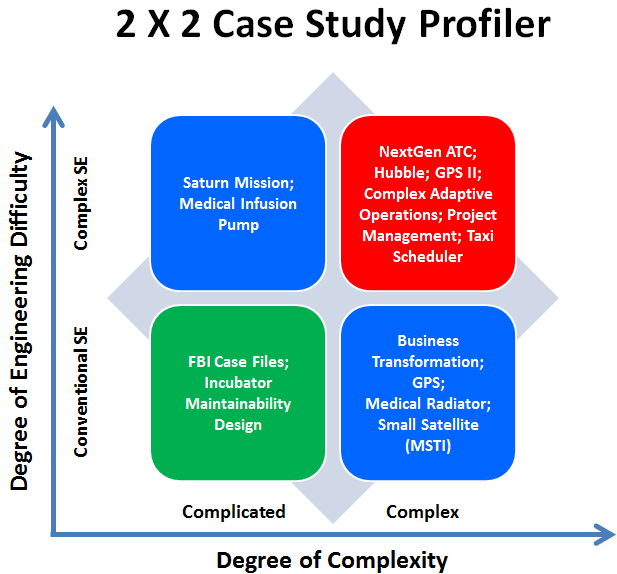Implementation Examples
Characteristics of the organization(s) which perform SE have an impact on the engineering itself. It is for this reason that the examples are grouped into three categories: government examples, commercial examples, and examples which represent issues from both ("combined"). As the SEBoK continues to evolve, additional categorizations may be developed. A matrix is used to map the specific systems engineering principles illustrated in each example to the associated SEBoK topics.
SEBoK Examples
- Construction System Examples - Coming Soon!
- CyberPhysical System Examples - Coming Soon!
- Defense System Examples
- Geospatial System Examples - Coming Soon!
- Information System Examples
- Management System Examples
- Medical System Examples
- Space System Examples
- Global Positioning System Case Study
- Global Positioning System Case Study II
- Russian Space Agency Project Management Systems
- How Lack of Information Sharing Jeopardized the NASA/ESA Cassini/Huygens Mission to Saturn
- Hubble Space Telescope
- Applying a Model-Based Approach to Support Requirements Analysis on the Thirty-Meter Telescope
- Miniature Seeker Technology Integration Spacecraft
- Apollo 1 Disaster
- Transportation System Examples
- Utilities Examples
Characterization of Examples
Systems engineering (SE) principles described in the SEBoK Parts 1-6 are illustrated in Part 7, Systems Engineering Implementation Examples. These examples describe the application of systems engineering practices, principles, and concepts in real settings and can be used to improve the practice of systems engineering by illustrating to students, practitioners, and those new to SE the benefits of effective practice and the risks of poor practice.
The examples here have been developed by examining previously published case studies from external sources that demonstrate the real-world examples of systems engineering principles. These case studies were then summarized by the BKCASE team. The summaries include links to the original documentation as well as links to the relevant areas of the SEBoK highlighted in the example.
Systems engineering (SE) examples can be characterized in terms of at least two relevant parameters, viz., their degrees of complexity and engineering difficulty. Although a so-called quad chart is likely an oversimplification, a 2 x 2 array can be used to make a first-order characterization, as shown in Figure 1.
The x-axis depicts complicated, the simplest form of complexity, at the low-end on the left, and complex, representing the range of all higher forms of complexity on the right. The y-axis suggests how difficult it might be to engineer (or re-engineer) the system to be improved, using Conventional (classical or traditional) SE, at the low-end on the bottom, and Complex SE, representing all more sophisticated forms of SE, on the top. This upper range is intended to cover system of systems (SoS) engineering (SoSE), enterprise systems engineering (ESE), as well as Complex SE (CSE).The distinctions among these various forms of SE may be explored by visiting other sections of the SEBoK. In summary, the SEBoK case study editors have placed each case study in one of these four quadrants to provide readers with a suggested characterization of their case study's complexity and difficulty. For sake of compactness the following abbreviations have been used:
- Business Transformation (Successful Business Transformation within a Russian Information Technology Company)
- NextGen ATC (Federal Aviation Administration Next Generation Air Transportation System)
- Saturn Mission (How Lack of Information Sharing Jeopardized the NASA/ESA Cassini/Huygens Mission to Saturn)
- Hubble (Hubble Space Telescope Case Study)
- GPS and GPS II (Global Positioning System Case Study)
- Medical Radiator (Medical Radiation Case Study)
- FBI Case Files (FBI Virtual Case File System Case Study)
- Small Satellite MSTI (MSTI Case Study)
- Medical Infusion Pump (Next Generation Medical Infusion Pump Case Study)
- Incubator Maintainability Design (Design for Maintainability)
- Complex Adaptive Operations (Complex Adaptive Operating System)
- Taxi Scheduler (The Development of the First Real-Time Complex Adaptive Scheduler for a London Taxi Service)
- Project Management (The Development of a Real-Time Complex Adaptive Project Management System)
- SWFTS MBSE (Submarine Warfare Federated Tactical Systems Case Study)
References
Works Cited
None.
Primary References
None.
Additional References
None.
